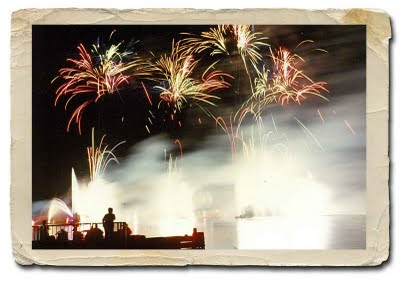Some time ago, July 30th to be exact, I posted an article entitled IllumiNations: The Introduction. In the article we briefly explored the opening of the nighttime spectacular. Here now, is Act One.
 The first act of IllumiNations is comprised of five pieces. They are Symphony No. 5 by Ludwig van Beethoven, Flight of the Bumblebee by Nikolai Rimsky-Korsakov, the Zampa Overture by Ferdinand Herold, the Italian Concerto by Johann Sebastian Bach and the William Tell Overture by Giachhino Rossini. Let’s look first at the first two pieces.
The first act of IllumiNations is comprised of five pieces. They are Symphony No. 5 by Ludwig van Beethoven, Flight of the Bumblebee by Nikolai Rimsky-Korsakov, the Zampa Overture by Ferdinand Herold, the Italian Concerto by Johann Sebastian Bach and the William Tell Overture by Giachhino Rossini. Let’s look first at the first two pieces.The first movement of Beethoven’s (1770-1827) Symphony No. 5 in C minor, Opus 67, was composed over a period of four years beginning in 1804 and premiered in Vienna in 1808. It opens with perhaps one of the most recognizable four measures in music. Written in two-four time, the work opens with 3 eighth notes followed by a sustained half note. This then repeats with the addition of a second sustained half note. The four-note motif repeats at various times throughout the first movement and subsequent three movements.
Little is known about the origins, or purpose for the creation of the Fifth Symphony. Some maintain is stands as the composer’s musical exploration of fate. Others look to an aborted love affair or a sense of patriotism in the wake of Austria’s loss during the Napoleonic Wars as its inspiration. In his life, Beethoven composed nine symphonies. The Symphony No. 5 (along with the Ninth which will be discussed later) is a testament to a career that experienced extreme highs and devastating lows which were marked with periods of sheer genius.
 Flight of the Bumblebee is from Rimsky-Korsakov (1844-1908) 1900 opera, Tale of the Tsar Sultan. It appears in Act III of the opera. Like the Symphony No. 5, it is also written in two four time but uses a nearly continuous stream of sixteenth notes and instead of plodding along at a steady pace, it is rendered at an extremely rapid pace. The piece appears as an interlude in which the Swan-Bird magically transforms the Tsar’s son into an insect (a bumblebee) giving him the ability to fly so that he may visit his father. A lyric, sang by the Swan-Bird, accompany the interlude:
Flight of the Bumblebee is from Rimsky-Korsakov (1844-1908) 1900 opera, Tale of the Tsar Sultan. It appears in Act III of the opera. Like the Symphony No. 5, it is also written in two four time but uses a nearly continuous stream of sixteenth notes and instead of plodding along at a steady pace, it is rendered at an extremely rapid pace. The piece appears as an interlude in which the Swan-Bird magically transforms the Tsar’s son into an insect (a bumblebee) giving him the ability to fly so that he may visit his father. A lyric, sang by the Swan-Bird, accompany the interlude:“Well, now, my bumblebee, go on a spree,catch up with the ship on the sea,go down secretly,get into a crack a little distance away.Good luck, Gvidon, fly,only do not stay long!”
The overture from the opera Zampa, was composed by Ferdinand Herold in 1831, two years prior to his death from tuberculosis. Zampa, is perhaps the most famous of his 22 operatic compositions.
Johann Sebastian Bach (1685-1750) published his Italian Concerto, or Concerto after the Italian Taste, in 1735. Bach composed a great of number of works for harpsichord and clavichord. The concerto was composed in three movements for a two-manual harpsichord. The third movement is entitled “Presto” and as the title implies, is played at a fast tempo. Though not as well known as his Goldberg Variations or the Brandenburg Concertos, the Italian has been widely recorded as favorite of the Bach concertos.
Gioachino Rossini (1792-1868) composed 39 operas during his lifetime. The opera William Tell was premiered in Paris on August 3, 1929. The Overture to the opera was written in four parts which include the Prelude, the Storm, The Ranz des Vaches (which translates ‘call to the dairy cows’) and that part which we are most familiar with, the Finale, or Galop.
 The Finale begins with a fanfare of trumpets signaling the beginning of a cavalry charge and is joined by full orchestra. This “charge” being presented in the Overture is a glimpse into Act IV of the opera where a rebel Swiss army, led by Tell, arrives and fights the battle that leads to the liberation of Switzerland.
The Finale begins with a fanfare of trumpets signaling the beginning of a cavalry charge and is joined by full orchestra. This “charge” being presented in the Overture is a glimpse into Act IV of the opera where a rebel Swiss army, led by Tell, arrives and fights the battle that leads to the liberation of Switzerland.Through the years the William Tell Overture has been interpreted and performed by a number of individuals and groups and has been featured in television and film. For a more whimsical musical interpretation, let me recommend Spike Jones and His City Slickers 1948 rendition. You’ll never listen the Overture the same way again.
The first act runs 2 minutes, 3 seconds long.
Next, we’ll look at the countries of the World Showcase through the music of Act II.
More to follow…
Next, we’ll look at the countries of the World Showcase through the music of Act II.
More to follow…
The photographs were taken by the author in 1994 using a Minolta 35mm camera.







No comments:
Post a Comment